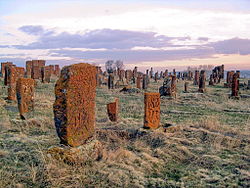Khachkar
A Khachkar or Khatchkar ("Խաչքար" in Armenian, meaning "cross-stone", pronounced as
Khachkar Media
The famous khachkar at Goshavank, carved in 1291 by the artist Poghos.
The famous 13th century Armenian-inscribed double khachkars of the Memorial Bell-Tower of the Dadivank Monastery
A 15th century khachkar at the Armenian Cathedral of Saint James, Jerusalem
Khachkars appear in large numbers in the Noratus cemetery.
A modern-day khachkar carver's workshop in downtown Yerevan.
IPA: [χɑtʃkɑɹ]) is a carved memorial stone found in Armenia.
It has a crucifix or cross, with a rosette or sun circle below it. Other parts can be filled with patterns of leaves, grapes or knots. Sometimes it has a ledge at the top with saints' or characters from the bible.
Much of the time a khachkar is put up for religious reasons such as the salvation of the soul of a living or a dead person. They have also been removed for other reasons, such as to show a military win, building of a new church, or as a protection from natural disasters.
Most Khachkars are in graveyards. But Armenian gravestones take many other forms, and only a small are khatchkars.









